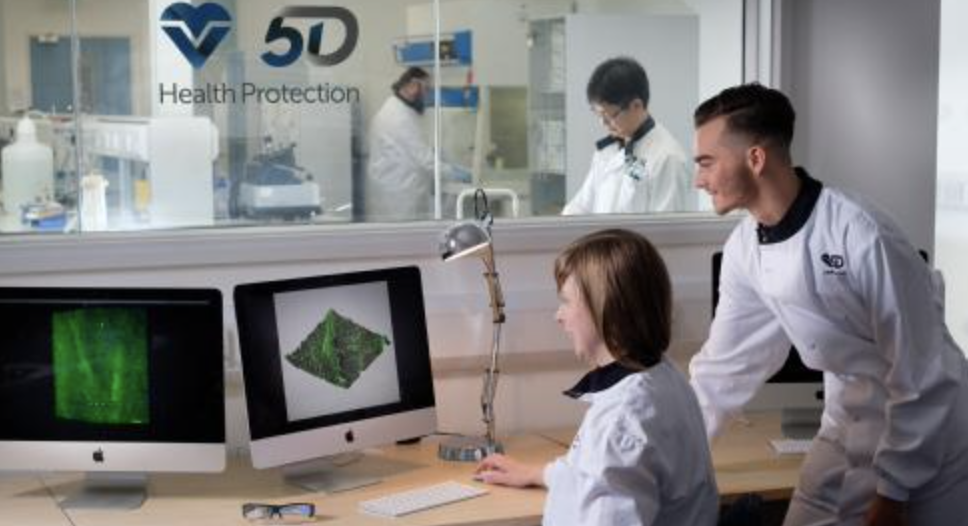Thank you to WMG for this case study! 5DHPG participated in the WMG Internship Programme to help them combine their smart next generation patent protected antibiofilm complexes into plastics to create anti-biofilm plastic for the use in the first instance in the automotive industry, to help curb the spread of viruses and other microorganisms such as antimicrobial-resistant (AMR) bacteria and fungi. Following the success of the project, the company are now in the trialling phase prior to the next stage of development.
About
5D Health Protection Group Ltd is a globally leading ISO 9001, UKAS 17025 and ISO 13485 accredited microbiology and contract research organisation (CRO) offering exceptional contract scientific testing services on a global scale.
Need for innovation
The 5D Health Protection Group Ltd is centred on the innovation of new, smart highly effective antimicrobials and surfaces, antibiofilm technologies, and new biomaterials and diagnostics utilising biosensor technology. They have a particular interest in the automotive sector and hope to make game-changing anti-microbial and anti-biofilm surfaces for use in vehicles to help stop the spread of viruses and antibiotic-resistant bacteria and fungi. 5Ds technology is becoming more relevant on a global scale in light of Covid-19 and its ability to remain both viable and therefore virulent for days on different surfaces.
In addition, other expected applications for their technologies and potential products are being developed for use in medical devices and healthcare, in order to reduce hospital-acquired infections (HAIs), dentistry, cosmetics, veterinary medicine, water and engineering and pharmaceuticals.
The infection prevention and control market is huge and there is an ever-increasing global demand for improvements in antimicrobial technologies that are ‘fit for purpose’ when biofilms are evident. Microbes growing within a biofilm are reported to be up to 1000xs more tolerant to antibiotics and other antimicrobials and are reported to be responsible for over 65% of all hospital-acquired infections.
Seeing the huge market potential for their next-generation anti-biofilm technologies, 5DHPG wanted to test the effectiveness of their newly developed antimicrobial agents when mixed with polymers. Creating a compound using these two materials was challenging, because they did not have existing expertise in-house. If achieved, this will be a new and unique product to the market that could potentially have a huge global impact on infection prevention and control in all industrial sectors where viruses, bacteria, fungi and yeast are a major health concern.

Innovation
5DHPG participated in the WMG Internship Programme in order to help identify ways to blend the antimicrobial and antibiofilm agents with plastic. Intern Manisha Pandey, a third-year Chemistry student, was selected to carry out the compounding of polypropylene (PP) with 5DHPG’s anti-microbial product and other additives – supported by WMG’s Technology Transfer Engineer, Chinemelum Nedolisa. The polymer and anti-microbial compounding was carried out in a twin-screw extruder in our tech hall. The extruded material was then pelletized and then compression-moulded using specialist equipment, and finally injection-moulded to create plaques. Plaques were then tested to evaluate the efficacy of the anti-microbial product.

Impact
The project delivered successful compounding of PP with 5DHPG’s anti-microbial and antibiofilm agent, and processing of the compounded material. Recent preliminary trials by 5DHPG demonstrated complete eradication of microbes that were grown in both the free-floating or planktonic state and the attached or biofilm phenotypic states. Finally, this project allowed 5DHPG to understand the effectiveness of their newly developed anti-microbial and antibiofilm product and to develop and improve the formulation further.
Future
Going forward, 5DHPG will carry out extensive trials of the product before it is commercialised. In two years’ time, when they are ready to launch the product with a commercial partner, they are expecting their product to significantly reduce the biofilms on surfaces, as well as reducing the transmittance of microbes via human contact and interaction.
















